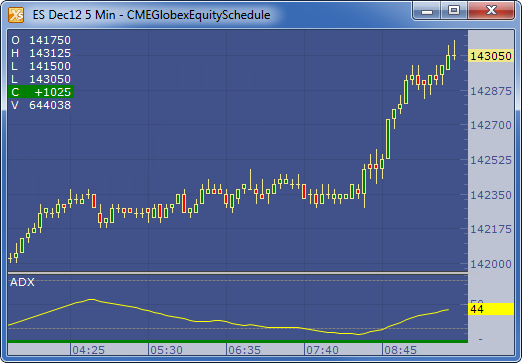Average Directional Movement
Average Directional Movement (ADX)
Description
The Average Directional Movement Index (ADX) is designed to quantify trend strength by measuring the amount of price movement in a single direction. The ADX is part of the Directional Movement system published by J. Welles Wilder, and is the average resulting from the Directional Movement indicators.
Formula
Directional Movement (DM) is defined as the largest part of the current period’s price range that lies outside the previous period’s price range. For each period calculate:
+DM = positive or plus DM = High - Previous High
-DM = negative or minus DM = Previous Low - Low
The smaller of the two values is reset to zero, i.e., if +DM > -DM, then -DM = 0. On an inside bar (a lower high and higher low), both +DM and -DM are negative values, so both get reset to zero as there was no directional movement for that period.
The True Range (TR) is calculated for each period, where:
TR = Max of ( High - Low ), ( High -PreviousClose ), ( PreviousClose - Low )
The +DM, -DM and TR are each accumulated and smoothed using a custom smoothing method proposed by Wilder. For an n period smoothing, 1/n of each period’s value is added to the total each period, similar to an exponential smoothing:
+DMt = (+DMt-1 - (+DMt-1 / n)) + (+DMt)
-DMt = (-DMt-1 - (-DMt-1 / n)) + (-DMt)
TRt = (TRt-1 - (TRt-1 / n)) + (TRt)
Compute the positive/negative Directional Indexes, +DI and -DI, as a percentage of the True Range:
+DI = ( +DM / TR ) * 100
-DI = ( -DM / TR ) * 100
Compute the Directional Difference as the absolute value of the differences: DIdiff = | ((+DI) - (-DI)) |
Sum the directional indicator values: DIsum = ((+DI) + (-DI)) .
Calculate the Directional Movement index: DX = ( DIdiff / DIsum ) * 100 . The DX is always between 0 and 100.
Finally, apply Wilder’s smoothing technique to produce the final ADX value:
ADXt = ( ( ADXt-1 * ( n - 1) ) + DXt ) / n
Example

Subscribe to:
Post Comments
(
Atom
)
Follow us
Popular Posts
-
Decision Bar Indicator – Profitable strategy for swing Daytrading Decision Bar Indicator – Profitable strategy for ...
-
XARDFX forex trading system 2020 – best trading results about In conclusion, I would like to share a few powerful tips th...
-
Magic Fx Formula indicator-V2 About : It’s sophisticated enough to impress experienced traders, yet is so simple to use that even co...
-
Momentum MT4 Indicator What is Momentum MT4 Indicator? Thе Momentum Indiсаtоr (MOM) is a leading indiсаtоr mеаѕuring a ѕесuritу...
-
Trading Magister V1 System Powerful Features & Functions ✓ Three Trading Strategies: Asia, Europe & A...
-
ZigZag Based on Close Prices - indicator for MetaTrader 4 The code is based on indicator ZigZag which is in-built in MT4, devel...
-
VR Moving Average Forex Trading Strategy is a day trading strategy that is traded on the 5-minute chart. While some would consider the ...
-
Daily Bonus Come everyday to claim your Daily Bonus! Bonus multiplicator will increase every continuous day you claim till the end...
-
download
-
Stochastic Elasticity Indicator DOWNLOAD
Powered by Blogger.
Blog Archive
- October (44)
Labels Cloud
Categories
Pages
Video of the day
About
About Me
© TRADEBASE4 ..2018-2019 . Powered by Lifehacktricksall . Tradebase4 .




No comments :
Post a Comment